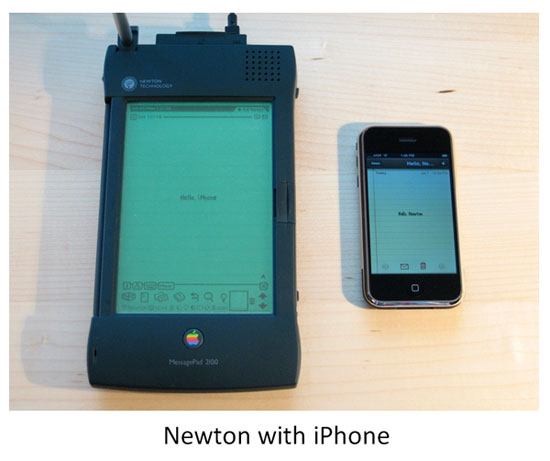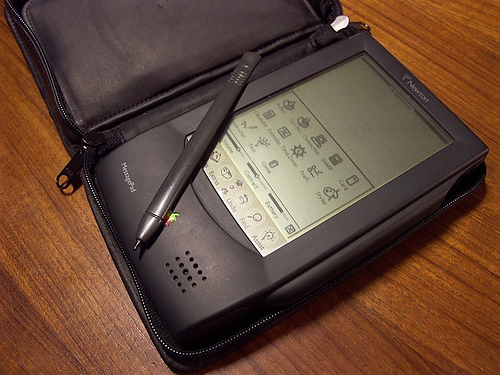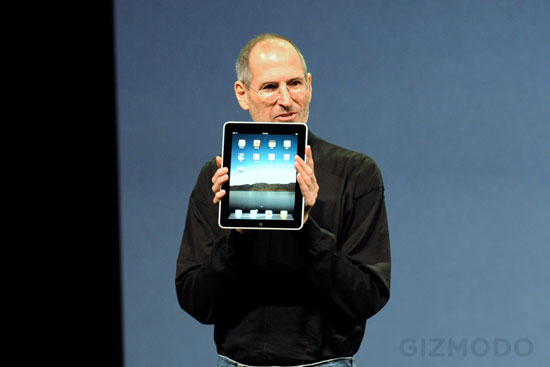Apple's Newton
by Andrew Boyd
Today, before there was "i." The University of Houston's College of Engineering presents this series about the machines that make our civilization run, and the people whose ingenuity created them.
iMacs. iPods. iPhones. Apple is among the most successful technology companies of all time. But the company's had its share of failures, too.
Perhaps the most visible was the Apple Newton. First released in the early nineties, it's often considered a predecessor to the highly successful iPad. Knowing Apple, it's easy to jump to the conclusion the company was simply ahead of its time. But the actual story's quite different.

Development of the Newton began in 1987, two years after Steve Jobs was forced from Apple. Apple's new CEO was intent on creating a device unlike any of the personal computers available at the time.
The idea was to create a computer with an interface like a sheet of tablet paper. Taking this idea to its logical conclusion, the new device would allow users to grab it from their briefcase and scribble notes on it. And that's how the Newton was designed. It came with a plastic pen and a touch sensitive screen.

A user could scribble "three o'clock meeting with Bob," setting in motion a chain of modern miracles. Handwriting recognition software would translate the scrawl, artificial intelligence software would intuit the meaning, and an appointment with the appropriate Bob would be scheduled. The concept was exciting. But the software wasn't up to it. Gary Trudeau, author of the comic strip Doonesbury, poked fun at the Newton's failings in a now legendary collection of strips known as the egg frecklesseries.
But handwriting recognition was only part of the problem. The Newton was plagued by a lack of direction from the outset. All products face a tradeoff between functionality and cost. Add too much functionality and the product prices itself out of the market. When the Newton finally went to market as the MessagePad, even the stripped down version was too expensive to be competitive. Steve Jobs killed the Newton shortly after he returned to head Apple in 1997.
Which makes the next chapter of the story that much more interesting. Jobs later went on to champion the iPad, which has proven an unmitigated success. What did Apple do differently under Jobs' leadership? The answer is surely open to debate. The iPad built on the success of the iPhone, whereas the Newton broke new ground. The iPad is sleek and sexy. The Newton was a grey slab of plastic. And the iPad doesn't tout handwriting recognition.

It does, however, tout voice recognition in the form of Siri, a program that talks as well as listens. And the goals for Siri are the same as those for the written word on the Newton. Thankfully for Apple, Siri's just one of many features — voice recognition remains frightfully error prone. But of one thing we can be sure. We're certain to hear more of Siri and her challengers in the days to come.
I'm Andy Boyd at the University of Houston, where we're interested in the way inventive minds work.
(Theme music)
In functionality, the Newton is more related to the class of devices known as personal digital assistants, or PDAs, than tablet computers. In fact, Apple coined the term PDA when referring to the Newton. However, with the Newton being modeled after a paper tablet, comparison with the iPad is common.
B. Gardiner. Learning from Failure: Apple's Most Notorious Flops. From the Wired Magazine website.
O. Linzmayer. Apple Confidential 2.0: The Definitive History of the World's Most Colorful Company. Sagebrush Education Resources, 1999.
The Story Behind Apple's Newton. From the Gizmodo website: http://gizmodo.com/5452193/the-story-behind-apples-newton. Accessed May 28, 2013.
The picture of the Newton with a pen is from a flickr website. The remaining pictures are from Wikimedia Commons.
This episode first aired on May 30, 2013.